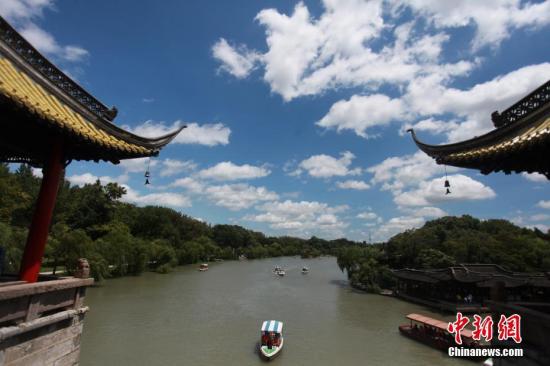China News Service, June 2. According to the official Weibo news of the Ministry of Ecology and Environment, the Ministry of Ecology and Environment held a regular press conference in May on June 2 to introduce the state of environmental quality and environmental monitoring in 2019. Bai Qiuyong, director of the Environmental Monitoring Department of the Ministry of Ecology and Environment, pointed out that the national ecological status index is on the rise, and the overall quality of the ecological environment remains stable.
Data map: blue sky and white clouds. Photo by Meng Delong
At the meeting, a reporter asked questions about "the main ecological and environmental problems facing the country".
According to Bai Qiuyong, according to the 2019 ecological status bulletin, in recent years, my country's ecological environment has generally improved. Here, I use three "increasingly" to express:
First, there are more and more blue sky. The annual average PM2.5 concentration of prefecture-level and above cities in the country has continued to decline. Since the 13th Five-Year Plan, the cumulative annual decrease has been 21.7%. The number of heavily polluted days has dropped from an average of 10 days to 6 days, a decrease of 40%. The "2+26" city dropped from 36 days to 20 days, a decrease of about 45%, and Beijing fell from 43 days to 4 days, a decrease of about 90%. The proportion of good days nationwide has risen overall, reaching 82% in 2019.
Second, the water quality is getting clearer. Since the "Thirteenth Five-Year Plan", excellent surface water bodies in the country have increased year by year, and heavily polluted water bodies have been reduced year by year. The proportion of state-controlled cross-section water quality has increased by 8.9 percentage points, and the proportion of inferior V has fallen by 6.3 percentage points. Tasks; The rate of compliance of the centralized drinking water sources in prefecture-level cities nationwide is maintained above 90%; the national seawater quality is stable and improving, the proportion of good water bodies in coastal areas has increased by 6.1 percentage points, and the proportion of inferior four types of water bodies has decreased by 6.6 Percentage points.
Third, the ecology is getting more and more beautiful. The national ecological status index is on the rise, and the overall quality of the ecological environment remains stable. The number of counties included in the national key ecological function area increased from 452 in 2012 to 817 in 2019, of which 12.5% of the counties' ecological environmental quality improved year-on-year.
Bai Qiuyong pointed out that the quality of China's ecological environment continues to improve, but the degree of improvement is still far from the people's expectations for a better life, and the goal of building a beautiful China. Ecological environmental protection is still facing a grim situation and still shoulders A difficult task. Specifically: In 2019, the average concentration of PM2.5 in prefecture-level and higher cities nationwide is 36 micrograms/cubic meter, which is 1 microgram/cubic meter less than the national secondary standard; PM2.5 in Beijing, Tianjin, Hebei and surrounding areas, Fenwei Plain The average concentration is about 1.6 times of the national secondary standard, and the regional air pollution process occurs from time to time; there are still 65 national test sections of the country whose water quality is inferior to Class V, and the water quality of the Yellow River, Huaihe, Liaohe, Haihe and Songhuajiang river basins is still It is lightly polluted; there are 72 centralized drinking water sources in prefecture-level and above cities in the country that exceed the standard to varying degrees; groundwater quality is generally not optimistic; there are still 13 bays in the coastal waters of the country in spring, summer, and summer. In the third phase of autumn monitoring, all of them were inferior to Category IV water quality, and there were still 8 rivers entering the sea with water quality of inferior Category V; the natural ecology in the central and western regions was relatively fragile.
Bai Qiuyong said that the task of ecological environment monitoring is arduous and heavy. "We will use a high sense of responsibility and mission to practice the sacred responsibilities of "top beams" and "lifelines", and use actual actions as support to win the battle of pollution prevention and control!"

